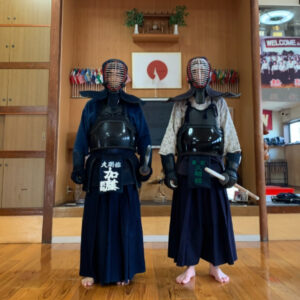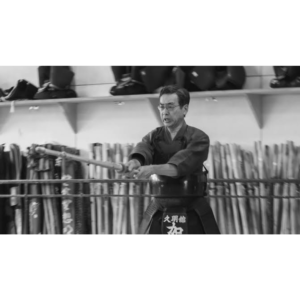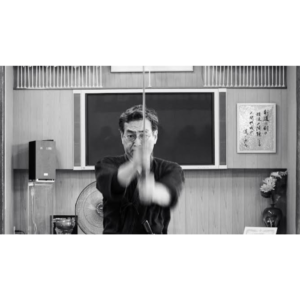Noah Saphier shares valuable lessons from Kato Sensei

Kato Sensei at the Kyumeikan dojo, Tokyo, Japan
August 14, 2023
How samurai traditions live on through Kendo - a sport rooted in ancient Japanese culture
Kendo – A Japanese martial art known for sword fighting – holds much deeper significance for those who practice it. The ancient tradition originating from the samurai spirit (Bushido) is also keeping cultural heritage alive in Japan.
The recognised sport existed before WW2 and its roots date back to the samurai period (1185-1868).
Today, Kendo is practiced across the world, with Sensei’s (teacher’s) keeping the history, cultural, and ceremonial aspects alive.
The sport follows four basic moves, which sees participants, who wear protective gear, gain points if they strike an opponent with ‘force and heart’ on the head (men), throat (tsuki), wrist (kote) and torso (do). Striking an opponent with heart includes saying the name of the attack strongly.
Kendo emphasizes the concept of ‘Ki-Ken-Tai-Ichi’ (spirit, sword, body in harmony) where effective strikes are achieved through the alignment of spirit, sword, and body. The heart represents mental unity, the sword represents technique, and the body represents posture.
The moment when these elements align at their highest level signifies ‘Ki-Ken-Tai-Ichi.’
Kendo has declined in popularity over the years due to the western world’s influence in Japan. However, there are those fighting to keep its cultural traditions alive for future generations.
Kato Sensei is one of them. The 66 year-old has practiced the martial art for 17 years after being inspired into it after initially setting up lessons for his son.
He has now turned his interest into a job and now teaches at Kyumeikan dojo (est. 1957) in Itabashi Ward, Tokyo, which sees 30 regular participants of all ages, and travelers from across the world.
I was one of those participants looking to deep dive into Japanese culture, having always had an interest in East Asia. Then last month, I got that opportunity to explore my interests further.
Part of my three-week experience in Japan involved sleeping in a temple, attending morning meditation with Buddhist monks at 5 am, sightseeing, and taking part in Kendo lessons with Kato Sensei.
During our time together, I learnt the valuable lessons which Kendo teaches and the connections between the sport and Japanese life in general, which includes not just the physical element but also a mental and “spiritual dimension with moral teaching” such as self-discipline, courtesy, patience, and humility rooted in Japanese society.
Speaking with Harbinger’s Magazine, Kato Sensei further elaborated on Kendo’s importance in Japanese culture, as well as how he applies it to his work life. “Kendo has various influences on modern Japanese everyday culture and spirit,” he said.
It places “great emphasis on etiquette towards others, as expressed by the saying ‘It begins with a bow and ends with a bow,’ reflecting the Japanese culture of valuing respect, harmony, and consideration for others.”
“Politeness, patience, and sincerity, which are important in today’s daily life, originate from the moral values of Bushido and represent significant aspects of contemporary Japanese culture.”
These principles I had just learnt felt completely in contrast to what I had learnt overseas in America.
When I was six I started my first taekwondo classes with a chain dojo in New Jersey but because I was learning taekwondo so far away from its origin, all of the philosophies and cultural practices behind it were westernized so it would appeal to a larger and younger audience.
However, my experience with kendo was much different, as I fully felt indulged in Japanese culture and learned many lessons which are not taught in American sports.
As an American, I witness many cases of un-sportsmanship through taunting and excessive celebrations. In addition, my perspective on martial arts was totally westernized, as my experiences were not authentic. Because of this, I experienced a culture shock when I heard that a sport with swords is more respectful than others in America.
The west is missing out on these rich cultural aspects. The lessons I now try to apply to my daily life include practicing mindfulness and showing strength.
Commenting on this subject, Kato Sensei said: “The cultural and ceremonial aspects of Kendo hold great importance. Kendo represents not only a sport or technique but also embodies a martial art rooted in rich history and tradition. It reflects the enduring spirit passed down through generations.”
While training in Tokyo, one of the lessons that I was taught was that while doing Kendo, one trains the mind just as much as the body. I was taught how this training can be applied to work and school life.
Kato Sensei also shared how he applies Kendo in his life. He currently serves as an advisor to corporations and is chairman of an non-profit organization, having previously worked as a deputy president of a major Japanese food company and general manager of a prestigious hotel chain.
He said: “I have used kendo as a means to strive for self-improvement in both my professional and personal life. Kendo has provided me with opportunities to reflect on my life more frequently, contributing to personal growth and benefiting various aspects of life.”
“While achieving victory is important, kendo also emphasizes the attitude of self-improvement, leading to a culture of cooperation and humility in social life.”
The Kyumeikan dojo has sister dojos, with three in China and others in Lithuania, Russia, Kazakhstan, and Italy.
These dojos have 3,000 alumni, with participants, which include parents, children, school groups and travelers, come from 50 different places around the world including China, Vietnam, Hong Kong, Mexico, Taiwan, Greece, the United States, and the United Kingdom.
Now that Kendo is practiced globally, there are questions over whether it could shift away from its cultural practices.
Kato Sensei said: “Depending on the country, the absence of suitable instructors might lead to adaptations in training methods or competition rules. Integration with new cultures and potential technical advancements in training could also occur.”
Other sports are becoming more popular in Japan, leading to a “decline in interest” in kendo. For example, baseball and soccer are gaining increasing traction – every game Japan played in the World Baseball Classic had above a 40.0 rating in Japan, which is what the Super Bowl draws in the US.
On the future of Kendo, Kato Sensei shared the struggles of getting into the sport in comparison to other martial arts like karate or judo, including a “higher financial barrier” due to the cost of equipment such as bamboo swords and protective gear.
He added: “Today’s focus on popular sports like baseball and soccer has led to a decline in Kendo practitioners. Passing on traditional values to the new generation requires effort and innovation.”
But Kato Sensei said people are visiting dojos and interest is coming in from parents who wish for their children to become “healthy, courteous, and sincere individuals.”
On a wider scale, the All Japan Kendo Federation (AJKF), founded in 1952, is also promoting and preserving the Japanese culture in kendo. It believes that ‘the promotion of kendo should center on the transmission of the “spirit of the samurai” through everyday training and competition, not just as a competitive sport’.
The federation states how ‘the promotion of kendo does not mean merely increasing the number of practitioners, nor does it mean to hold more competitions’.






